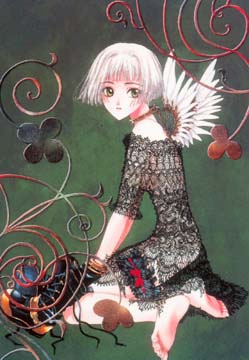

DRAWN & QUARTERED
Graphic Arts As Literature

In belated honor of Free Comic Book Day, I shall step away from my usual focus on anime and turn to the printed equivalent: manga, as Japanese comic books are called. Clever ‘Clover’ succeeds
in subtletiesBy Wilma Jandoc
wjandoc@starbulletin.comFor those familiar with "Card Captor Sakura" or "Magic Knight Rayearth," you have been introduced to two of the many works of CLAMP, a group of Japanese female artists. Originally numbering six members, CLAMP now has four: Mokona Apapa, main artist; Nanase Ookawa, story writer; Satsuki Igarashi, art assistant; and Mikku Nekoi, art assistant.
The group's better-known works include "Tokyo Babylon," "Angelic Layer," "X" and "RG Veda." Its repertoire of stories and art ranges wildly, from the cute whimsical fantasy of "Card Captor" to the dark foreboding of "X."
One of the latest CLAMP works to hit America in English is "Clover," a somber tale that takes place in a future technological society full of synthetic materials and in which true nature -- plants and animals -- is rare.
Enter Kazuhiko Fay Ryu, a retired secret agent who has racked up some big black marks. A high-ranking official calls in a few favors and asks Kazuhiko to look after a girl named Sue.
The girl is a rare "sorcerer child" sought by the government for something called the Clover Leaf Project. The most powerful children were termed three-leaf clovers and four-leaf clovers.
Sue is the sole four-leaf and understands that her magic is enough to destroy the world, so she lives alone in a mansion heavily guarded by seemingly cute animals dressed in clown costumes that are actually the latest-model "killer dolls."
An unknown enemy wants Sue for her power, so Kazuhiko must protect the girl as they journey to a place called Fairy Park. Once there, he discovers just how closely Sue is linked to a tragedy in his past.
Unlike the detailed lavishness of the most of their manga, CLAMP went to the other end of the spectrum and took a minimalist approach with "Clover" that emphasizes Sue's loneliness. The manga leaves plenty of white space that sometimes make the story difficult to follow. It occasionally switches gears and accentuates the negative space, surrounding the art with pure blackness during emotional moments.
The story art is usually framed within thin rectangles or small squares, mainly close-ups of the characters that give only a portion of the setting. Scenes are sparsely illustrated, leaving most of the background details to the reader's imagination.
Instead, the art of "Clover" is character-oriented, with great detail paid to their appearances and the mechanical tools they use. But dialogue bubbles often are not attached to anyone, so it's difficult at times to figure out who's speaking.
Among the manga's focal points are songs printed on the inside flap of the dust jacket, verses of which are repeated throughout the story almost to the point of dullness. The songs, the main link between Sue and Kazuhiko, change with each volume.
Though CLAMP's free use of white space may make the manga appear an amateurish attempt, the emptiness is just as powerful as the busy action of, for example, "Magic Knight Rayearth." The fragmented art as much as the story line reveals only bits and pieces, enough to capture your attention and keep you turning the page.
Not that there isn't any action in "Clover." On the contrary, there's a lot of it, with Kazuhiko's skills ending a situation almost as soon as it begins. A minimal focus on movement gives the feeling of being both in slow motion and fast-forward at the same time.
While "Clover" is a giant leap away from CLAMP's usual drawing style, the plot remains the driving force. Currently at four volumes, it makes for a short but engrossing read.
The domestic manga is published by TokyoPop, which gave this title the sterling treatment: Domestic releases are almost exactly like the imports, down to the translucent dust jackets and songs printed in both Japanese and English. Even the chapter titles are in their original language, with English subtitles.
"Clover" also has four compilations in Japan. It was serialized in the Japanese magazine Amie, which was canceled in 1998 about a year after it began, so it's anyone's guess whether CLAMP will finish the story.
And it might take more than a wish on a four-leaf clover for that.
Click for online
calendars and events.